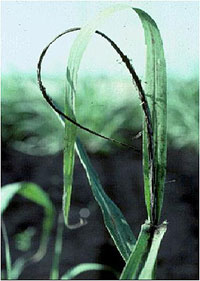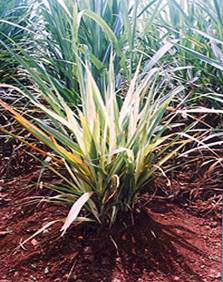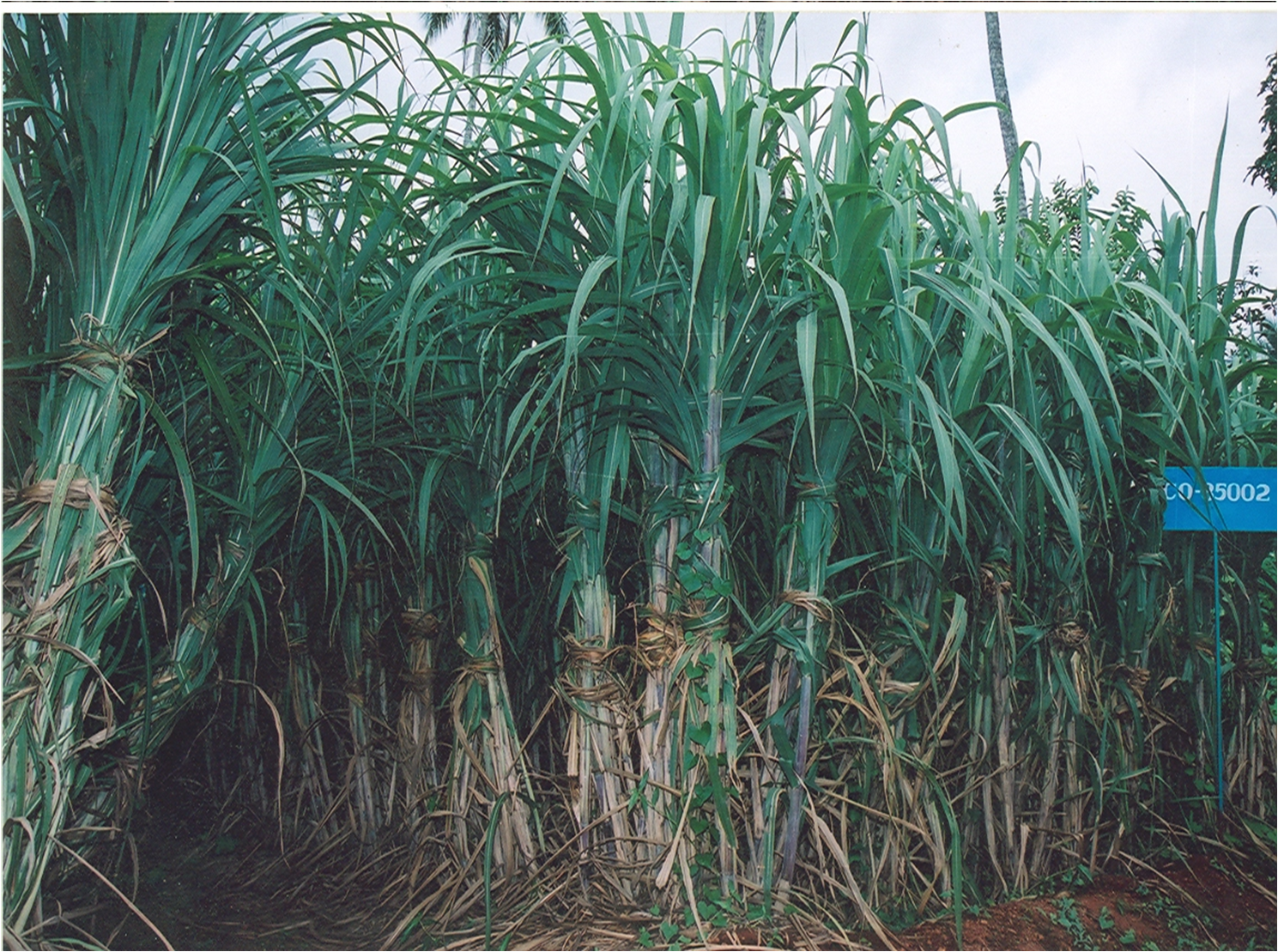
Crop: Sugarcane
Scientific name : Saccharum officinarum L.,
Common / Local Name : Ganna/Uss

Sugarcane (Saccharum officinarum L.,) is an important cash crop cultivated in India. In Goa, sugarcane is presently grown over an area of approximately 912 ha. The annual production of cane in Goa is about 49,108 tonnes with an average productivity of 53-55 mt/ha with a recovery of 8.5 per cent, which is very low. Goa has a sugar factory with a crushing capacity of 1.75 to 2.00 lakh tonnes of cane annually. Thus the present availability of cane meets less than half of the requirement of the factory. This deficit is met by bringing cane form neighbouring states, which is not only uneconomical but detrimental to the interest of local growers. Thus, there is tremendous scope to produce the cane locally by adopting improved technology package strategy. Further, there is a scope for bringing additional area under this cash crop especially in command areas of Salaulim and Anjunem irrigation projects.
Stepping up per unit productivity of both plant as well as ratoon cane atleast to a minimum level of 100 mt/ha is possible by following sound management practices and making available all the critical inputs like quality planting material, irrigation water, machinery in time and strengthening extension services.
Proper land preparation is very essential for good establishment and vigorous growth of the crop. Plough the field to a depth of 1.5 to 2 foot deep with the help of a tractor and expose it to hot sun for about a fortnight. Thereafter, crush the soil clumps so as to make it soft and friable. Then apply 10-12 tonnes of well decomposed cowdung manure or compost / ha and cross plough the field in opposite direction to the first ploughing to a depth of 30-50 cm. This will incorporate the manure into the soil. Then level the field to facilitate irrigation. After this, open the furrows with the help of a tractor drawn ridger at a distance of 90 cm. It has been observed that if the direction of the furrows is kept facing East-West, the crop grows luxuriantly and results in better sugar accumulation. Then the field is laid out in convenient plots depending on the slope of the land by bunding and providing irrigation channels. The length of rows may vary depending upon slope.
Before planting the setts, another 10-12 tonnes of compost/cow dung manure along with the basal dose of fertilizers (250 kg N 125 kg P2O5 and 150 kg K2O) are applied in the furrows at a depth of 10-12cm and the soil is mixed by light digging before planting. It should be remembered that addition of sufficient quantities of organic manures will not only improve the physical condition of soil but also increase the water retention capacity and such soils can withstand intermittent drought conditions due to water stress. Soils rich in organic content give higher yields and quality cane.
Both wet method and dry method of planting can be adopted for growing cane. Wet planting is mostly done in low to medium fertile soils. In this method, the furrows are thoroughly irrigated and treated setts are placed 3-5 cm deep ensuring that all the eye buds face upwards. The simple technique is to place the thumb on the middle bud and press the sett in the wet furrow ensuring that the other two buds remain sideways facing upwards. In highly fertile soils, dry method of planting can be adopted. The setts are planted in dry furrows at specified distances (end to end incase of 3 budded, 22 to 30 cm in case of 2 budded and 30-45 cm in case of one budded setts as described before) and covered with soil upto half the depth of furrow and the field is then irrigated. Subsequent earthing-up operations during top dressing of fertilizers in the ridges becoming furrows which serve as irrigation channels.
This is one of the major factors which have direct bearing on the yield of sugarcane. While selecting any variety for planting, due attention ought to be paid to know details such as yield potential of the variety, tolerance to diseases like grassy shoot and 'whip smut', its tolerance to withstand water stress, etc. To enhance more sugar production in Goa, maximum area should be covered with high yielding and high sugar content varieties with multiple pest tolerance.
A number of varieties have been evaluated for their suitability at ICAR Research Complex for Goa. Results of earlier trials indicated a high yielding midlate variety viz. Co-7527 which has yielded 150 Mt/ha as plant cane and 100 Mt/ha as ratoon is better under Goa conditions. Popularization of this variety and its rapid multiplication and use would go a long way to increase the present production. C0- 85002 is another such variety suitable to Goa conditions with yield of 120-130 t/ha but the sugar recovery of the variety is only 8.3%. Further studies made to recommend suitable replacement for Co-740 indicated that an early duration variety CoC-671 is better both for higher yield and better recovery especially as a plant cane. Another variety Co-86032 is a midlate variety which is popular in Maharashtra (with coverage of nearly 42 % of the area) was found to be more consistent both for plant cane and ratoons with an average yield of 92.8 t/ha and sugar recovery of 9.95%. Efforts should be made to popularize this variety in Goa and bring maximum area under cultivation.
Variety |
Duration |
Yield Potential |
Recovery |
Special Features |
CO- 85002 |
10-11 |
120-130 |
8.00-8.5 |
High yielding, thick erect canes with partially hallow pith |
Co- 740 |
11-12 |
70-80 |
8.00-9.00 |
Good ratooner, susceptible to pest and diseases |
Co- 86032 |
11-12 |
90-100 |
9.0-9.5 |
High yielding, better recovery with consistency in ratoon performance |
CoC- 671 |
10-11 |
90-100 |
9.5-10.0 |
High tonnage with high recovery, good for plant cane |
SNK-707 |
10-11 |
90-100 |
9.0-10.0 |
Drought tolerant and early |
Co-7527 |
10-11 |
100-120 |
8.5-9.0 |
High yielding as plant cane |
SNK- 632 |
10-11 |
120-140 |
8.0-8.5 |
Drought tolerant and early, stout canes with early side tillers |
SNK-49 |
10-11 |
100-120 |
9.0-10.0 |
White wooly aphid tolerant |
Sugarcane is a heavy feeder, since the crop remains in the field for about a year. It requires sufficient nutrition at various stages of its growth. The cane quality and yield is decided on the time, method of application and quantity of fertilizer applied. Fertilizers are expensive inputs and judicious use of this input becomes imperative. Sugarcane requires 250 kg N, 125 kg P2O5 and 150 kg K2O/ha under local conditions. However, the exact quantities of fertilizers to be applied to a particular field are decided on the basis of soil test report. The quantity of different fertilizers locally available and the time of their application/ha is given in Table. The farmers can choose from either straight fertilizers (NPK) or complex fertilizers i.e. Suphala and Uramphos as per their local availability. The fertilizers are placed below the setts and while top dressing they should be placed 8-10 cm away from rows and 6-8 cm deep in the soil and earthed up. The field should be irrigated on the next day. Application of Zinc to sugarcane has found to influence sugarcane yields. Experiments conducted at ICAR Research Complex have shown that application of 10 kg ZnSO4 / ha along with 300:150:150 kg NPK/ha recorded more cane height, weight, girth and yield. It resulted in about 9-12 per cent increase in yield over control. It is advisable to use Phosphate Solubilizing Bacteria (PSB) Culture along with organic manure/ compost @ 10 kg/ha for optimizing phosphorus uptake.
Table1. Quantity of individual fertilizers (kg/ha) and the time of their application to meet recommended dosage (250 kg N:125 kg P2O5:150 kg K2O /ha)
This is the most important aspects of sugarcane for realizing higher productivity. The utility of water will be enhanced if the soil is rich in organic content. Water is a valuable commodity and its use should be made in a most appropriate manner. Moisture conservation methods like addition of adequate quantities of organic manure to soil and trash mulching of top soil @ 15 ton/ha helps in conserving soil moisture.
In general, sugarcane requires 120 to 140 acre inches of water including the rain water. In sandy loam soils, irrigate the channels and then take up planting. In clay soils, plant the setts first and then irrigate. During germination period (30-40 days), irrigate at 10-12 days interval at 5 cm depth. During tillering stage, the frequency of irrigation may be 8-10 days. In Goa, for a February planted crop, irrigation is to be given at an interval of 8-10 days till May, depending on soil type. In all, 12 to 14 irrigations are required till monsoon sets in. From October to December, 5-6 irrigations at an interval of 12-15 days may be given. In all about 18-20 irrigations are sufficient to raise a healthy crop. However, the following techniques would help in economizing frequent use of water:
- Addition of organic manure @ 20-25t/ha.
- Spreading sugarcane trash as soil mulch @ 15 t/ha.
- Giving irrigations through alternate furrows.
- Adopting paired row method for planting cane.
- Installing water saving modem irrigation systems such as sprinkler, drip or biwall.
- Sugarcane Wooly Aphid:
- Use of wooly aphid tolerant varieties suitable foe Goa region such as SNK-49, SNK-44, SNK-61 and SNK-754.
- Soil application of Phorate 10G @ 10 kg or Carbofuron 3G @ 30 kg /ha in infested crop not more than six months old. The granule should applied with due precautions, along the row side at the base of the plant fallowed by light irrigation, if required.
- Foliar application of Dimethoate 30 EC @ 0.05%, Metasystox 25 EC @ 0.04%, Acephate 75 SP @ 0.1% and Endosulphan 35 EC @0.05%.
- Destroy all infested shoots.
- Spray the crop with 35% Endosulphan by mixing 14 ml in 10 litres of water 3-4 weeks after germination or spray 50% BHC @ 3 kg in 500 litre water twice at an interval of 10 days, or
- Apply in furrows, 6% Gamma BHC (Lindane) @ 16 kg/ha and irrigate. This will also control termites.
- Avoid late planting of cane.
- Do adequate hoeing.
- Release of biological control agents such as Trichogramma eggs @ 5 lakh/ha or spray with 300 larvae infested with granulosis virus in 250 litres water.
- Do not use infested setts for planting.
- Infested cane should be harvested early and the trash burnt. No ratoon is advisable from such crop.
- Plough the field immediately, collect stubbles and burn them.
- Provide adequate irrigation.
- Treat the setts with 30% Dimethoate (Rogor) @ 265 ml or 85%Phosphomidon @ 80 ml or 50% Malathion @ 300 ml in 100 litres of water by dipping the setts for 3-4 minutes before planting.
- Use granular Phorate @ 10 kg/ha when tillering is over.
- Locate the termetoria to locate the queen and destroy it.
- Apply 20% Gama BHC 5 litres in 1,000 litres water in furrows.
- Elongate water- coloured lesions, roughly 1-2 mm in length and 0.5-1 mm in width, develop on the youngest leaves of affected plants, their long axes parallel with the leaf veins.
- Within a few days they increase five fold in size; their centres become chocolate brown in colour and occupy most of the areas of infection.
- Lesions extend from the points of primary infection towards the leaf tips. They pass through colour changes similar to those of the original lesion and turn from pale yellow to dark brown.
- In severe cases, growth is retarded and short internodes are formed.
- The tissue, which at first turns red, remains firm; and smell of pineapple fruit might be noticed. Later, after the parenchyma has been destroyed, the interiors of the setts become black and hollow.
- Infected setts fail to germinate.
- The earliest symptoms are seen on the young leaves, which become chlorotic towards their bases, twisted and wrinkled, and are narrower and shorter than normal levels.
- Irregular reddish stripes develop within the chlorotic parts.
- If infection is limited to the leaves, the plants usually recover; if not, internal and external ladder-like lesions develop in the stems.
- In severe cases the growing-points die and rot.
- The first symptoms of injury depend on the method of infection. If the fungus has gained entry into the stem through the nodes, wounds or pest injury, red rot will begin at those points and will extend slowly or rapidly depending on the resistance of the variety.
- If the infection is raising up the stems from underground parts, the vascular bundles will first turn red before the other tissue also becomes red, sometimes interrupted by white blotches.
- The sucrose content of the affected parts is greatly reduced.
- External symptoms appear only in the later stages of the disease when ill-defined red patches may appear on the rind before the stems dry out and shrink.
- In severe cases, establishment of young plant cane is affected.
- Formation of characteristic whip-like, pencil-thick unbranched structures from the apices of affected stem.
- Each structure comprises a core of parenchyma and fibrovascular elements surrounded by vast numbers of chlamydospores, enclosed at first in a thin, silvery sheath.
- Later, when the membranous covering splits, the exposed chlamydospores resemble a thick layer of soot. They are then dispersed, mainly by wind.
- Smut is transmitted in two ways: by windborne spores gaining entry into standing cane through the buds; and by spores in the soil, or in irrigation water, entering planted setts.
- Infected buds may develop quickly into whips, or the mycelia may remain dormant within the buds to form a latent source of disease if the stems are used as a seed-cane.
-
In mature stems the leaf trace vascular bundles might become orange-red, but the discoloration does not extend into the internodes.
-
In immature stems there might be a diffuse salmon-pink discoloration in the younger nodes, spreading into the parenchyma of the upper internodes.
- Development of a typical pattern of elongated yellow chlorotic areas interspersed with similarly shaded patches of light and dark green.
- The loss of effective leaf area causes stunted growth, but the damage differs greatly according to the variety being growth and the strain of the virus.
- Pencil line like yellowish streaks on the leaves
- Scalding of leaves from margin to the centre
- Profuse tillering-thin papery white leaves
- Stunting and reduction of internodal length
- No millable cane formation
- Foliar : Yellowing , Withering, Drying
- Stalk drying
- Internal : Diffused purple or muddy colored pith
Due to the slow initial growth of crop, the irrigation channels as well as ridges and inter row spaces get infested with variety of narrow and broad leaved weeds which pose a serious problem to cane growers, causing losses up to 60-70 per cent in neglected fields. The initial period of 2-3 months of the crop (depending on the variety) is very crucial for control of weeds. Use of sugarcane trash mulching is very effective in controlling weeds. The weeds are either manually removed during hoeing or are killed by use of herbicides. For narrow leaved weeds and grasses, spray 2 kg Atrazine dissolved in 100 litres of water, 4-5 days after planting when there is enough moisture in the soil. In case of heavy infestation, give second spray after 4-5 weeks. For controlling broad leaved weeds chemically, use 1.75 kg 2, 4-D after the emergence directing the spray on weeds.
Use of herbicides should be done in the morning or evening. The operator should walk in reverse direction to avoid trampling of the sprayed area. While spraying all the bunds, channels, ridges etc. should be adequately covered with herbicidal spray.
Sugarcane in Goa is infested by following pests and diseases. Their nature of damage and control measures is suggested below:
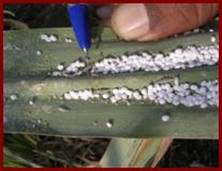
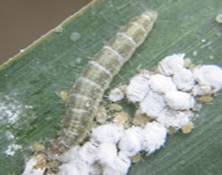
Sugarcane woolly aphid is a foliage sucking pest. Wooly aphid earlier was known to be minor pest in India has now assumed the status of economic pest after its severe outbreak in Maharashtra during July 2002. It feeds on sugarcane by inserting their stylets through the stomata of the plants leaves. Both nymphs and adults suck the cell sap from lower surface of leaves. They suck the sap from phloem. They excrete large amount of honey dew which falls on the leaves giving them a sticky coating on which black sooty mould (Capnodium sp.) develops making the leaves look all black. Due to the thick coating of sooty mould process of photosynthesis is significantly hampered in severely infested plants, thereby causing considerable reduction in cane yield (25%) and sucrose content (26.71%), whereas, during the early growth period plants may die.
Management
2. Early shoot borer
This insect pest can cause up to 30% losses in sugarcane crop. Under Goa conditions, this pest is noticed from March to May. Hot climatic conditions and low humidity are the predisposing factors for spread of this pest. The female lays eggs in rows in straight lines on the under surface of leaves. The larvae after hatching bore a hole into the growing cane near to the soil surface and feeds on tender portion. This results in death of the central shoot by gradual drying.
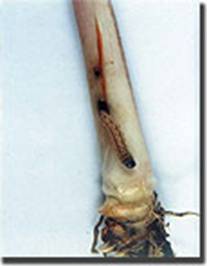
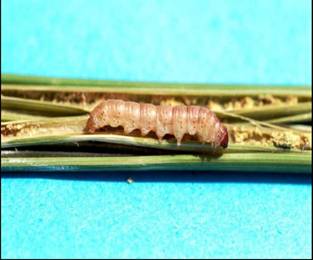
Management
3. Stem borer
The stalk borer in advanced stage infests the sugarcane crop as stem borer. This pest is found during tillering stage and beyond and it makes holes in the cane and feeds on inner contents. These holes are concealed under the dry leaves. The incidence of this pest is favoured by hot weather from February to May.
Management: Adequate control of early shoot borer will ensure crop free of this pest.
4. Scale insect
This pest infests the cane when the tillers start maturing. The nymphs and adults stick on the outer surface of cane and suck the sap, thus devitalizing the plant. The crop remains stunted and dries up. The spread of this pest is through infested setts, air and ants. This pest is more pronounced in ratoon crop. It causes 30-35 per cent weight loss and 2 to 3 cent reduction in sugar recovery in heavily infested crop. Use of infested setts for planting, neglected ratoon, poor soil, water scarcity and draught in summer are some of the predisposing factors.
Management
5. Termites
This insect pest damages the crop at two stages. Once when the setts are planted, when the worker class of termites feed on the tender eye bud resulting in poor germination. They also feed on cut ends of setts and cause germination losses. Later on when the cane is fully grown, they feed around basal portion as well as cane portion near ground. Their feeding results in drying of cane.
Management
In addition to above, the sugarcane is also infested by sap sucking insect pests such as white flies and mealy bugs. These can be controlled by spraying any systemic insecticide.
6. Rats
A rat causes damage not only to sugarcane but many other crops. Burrowing of rats into water channel causes loss of water. The rats due to their gnawing habit causes 10% more damage to cane than by eating it. The site of damage is near the joints where the cane is hard. Their damage causes cane to dry and lose weight. Lodging of cane is many times attributed to burrowing of rats near the base.
Management: Identify the live burrows on bunds and in the fields. Baiting is necessary if Zinc Phosphide is used.
More recently, ready to use rodenticide, Bromdiolone 0.005% (Moosh Moosh) or rattol is found to be an effective rat killer. Place 1-2 cakes in each live burrow along bunds, 2-4 weeks after planting. Cakes are also distributed in field after earthing up at 10-15 m interval. About 30-50 cakes are required for one acre. The rodent control work should be done on a collective basis rather than individually.
7. Wild boars
This is also a menace to sugarcane growers. This can be kept away by having battery operated fencing.
Eye spot
Causal organism: Drechslera sacchari (Helminthosporium sacchari)
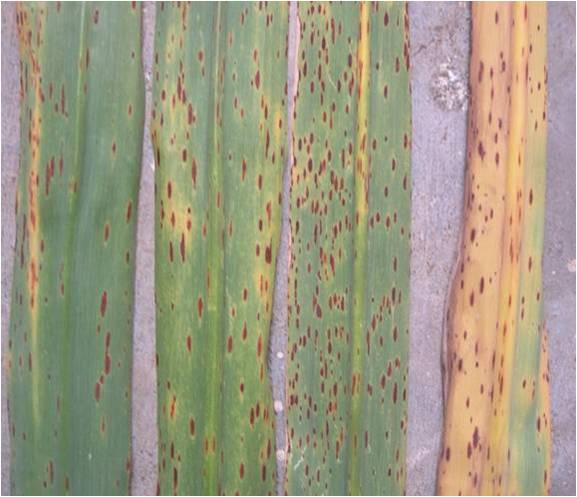
Symptoms
Pineapple disease/ Sett Rot
Perfect state: Ceratocystis paradoxa (Imperfect state: Thielaviopsis paradoxa)
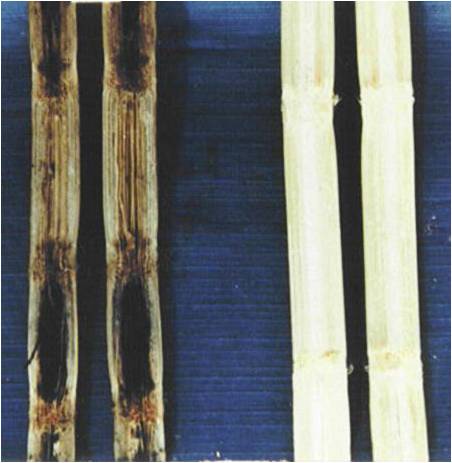
Symptoms
Pokkah boeng
Perfect state: Gibberella fujikuroi (Gibberella moniliformis) (Imperfect state: fusarium moniliforme)
Symptoms
Red rot
Perfect state: Glomerella tucumanensis (Physalospora tucumanensis) (Imperfect state: Colletotrichum falcatum)
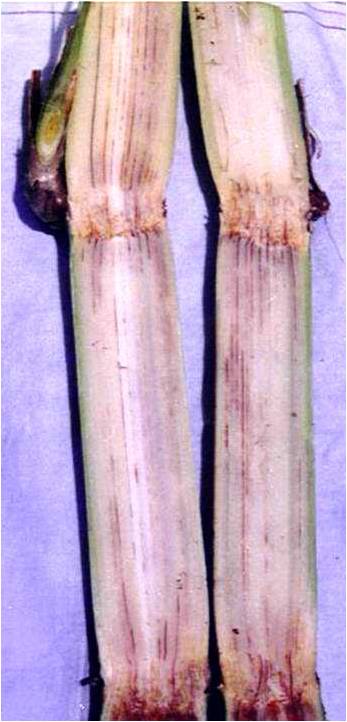

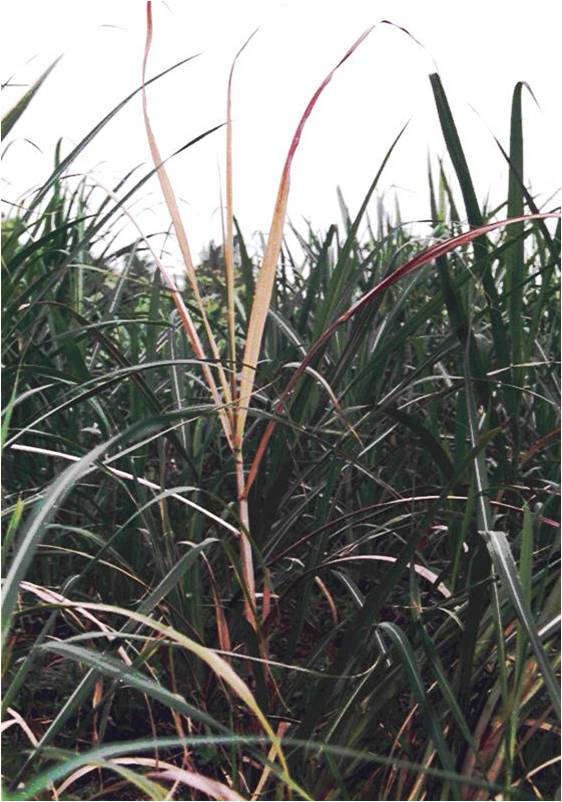
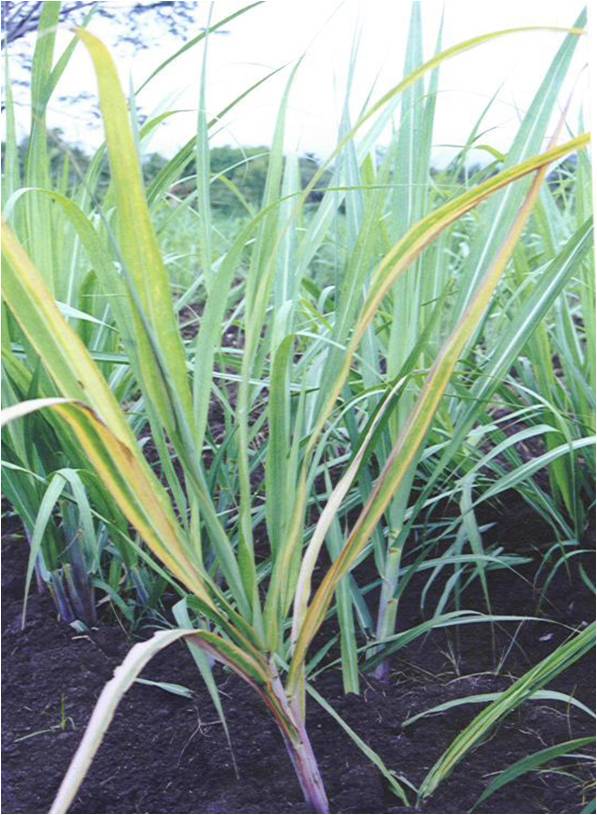
External Symptoms
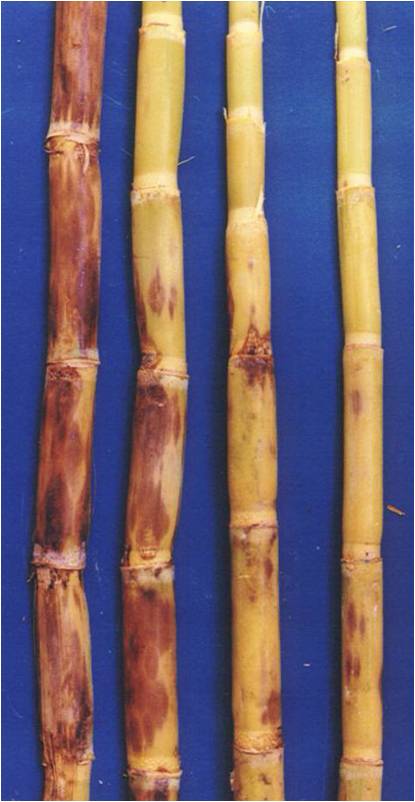
Internal Symptoms
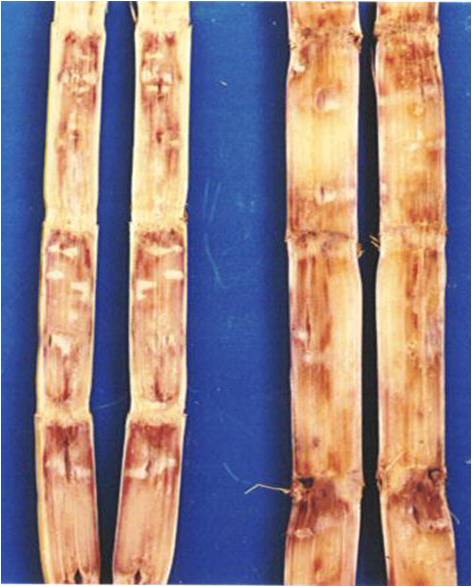
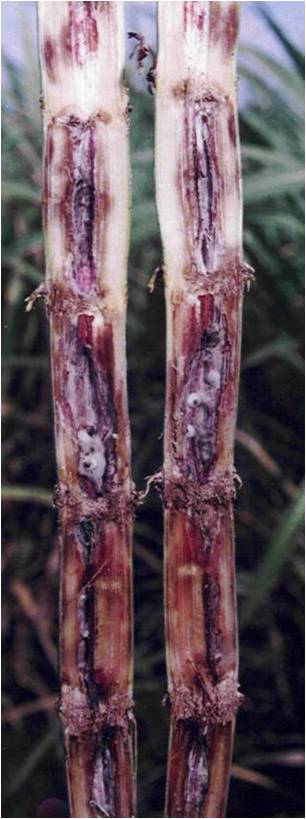
Symptoms
Smut
Causal organism: Ustilago scitaminea
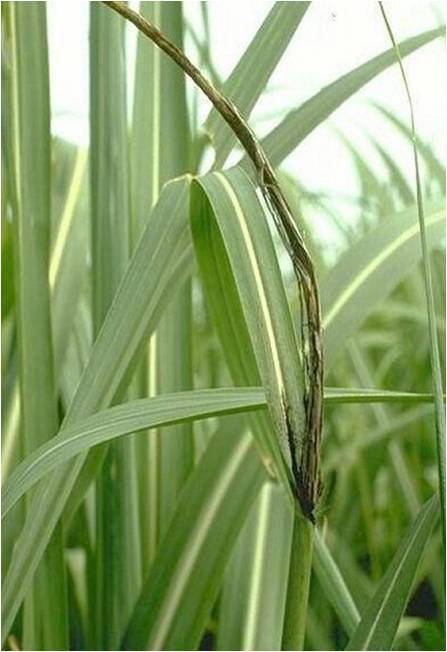
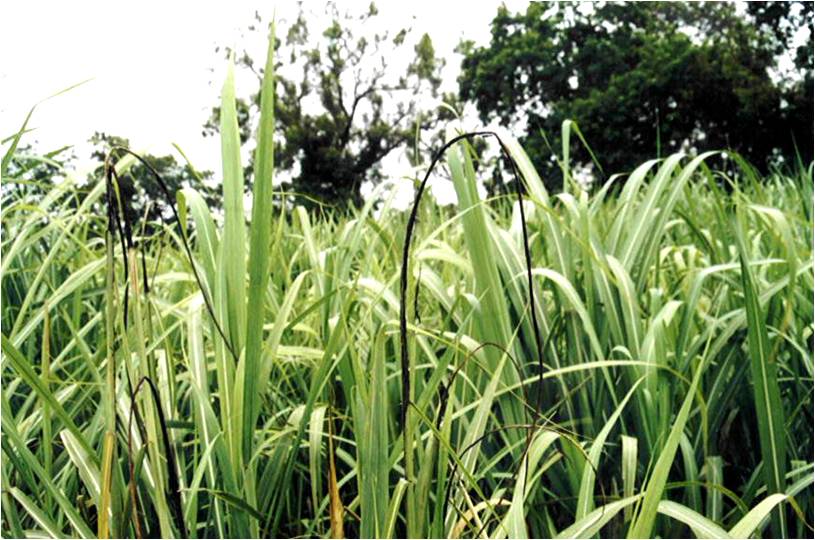
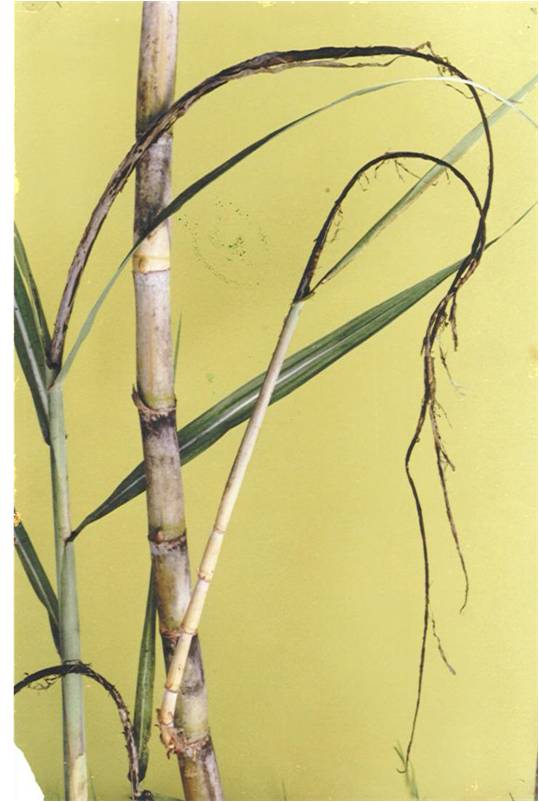
Symptoms
Ratoon stunting disease (RSD)
Causal organism:
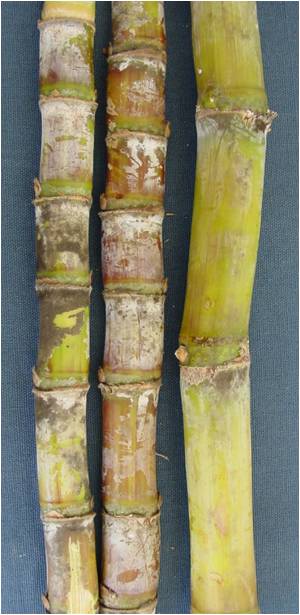
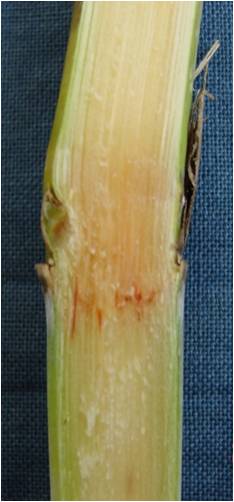
Symptoms
The external symptoms, uneven growth and an unthrifty general appearance, have no diagnostic value; and for several years RSD was thought to be without recognizable characteristics. Hughes Steindl, and Egan (1968), however, eventually found two internal symptoms sometimes associated with disease:
Some varieties show neither symptom, some show both and some show one but not the other. Moreover, the intensity of their expression is influenced by physiological and climatic conditions.
Mosaic disease
Causal organism: Sugarcane mosaic virus
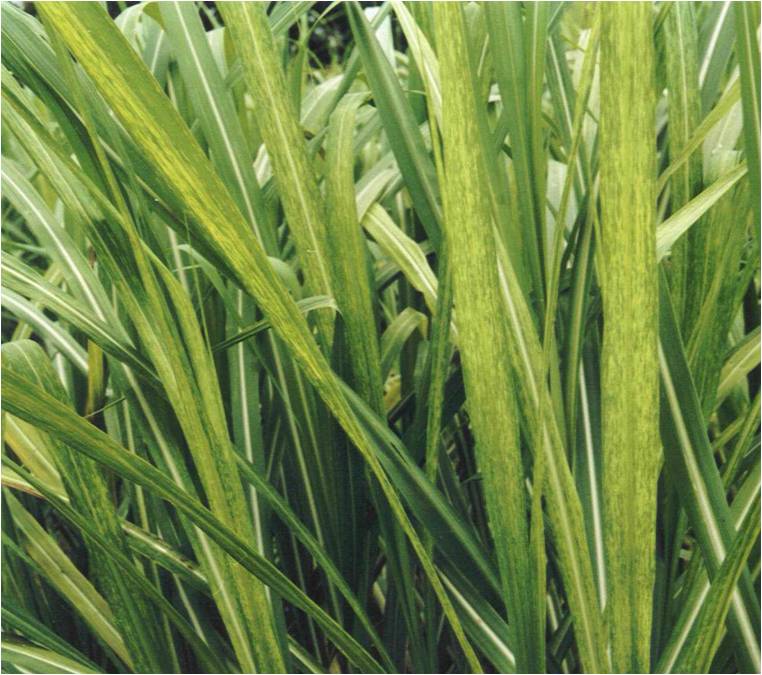
Symptoms
Leaf scald
Causal organism: Xanthomonas albiliniens
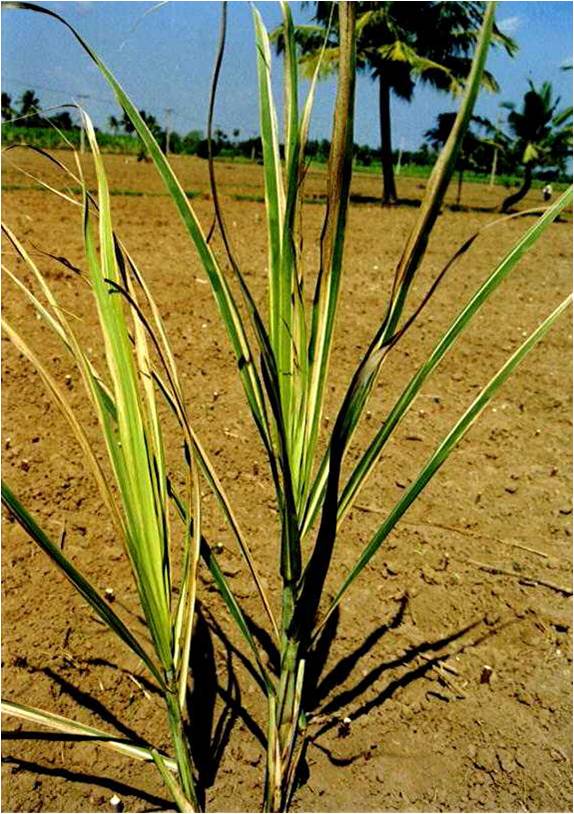
Symptoms
Yellow leaf disease (syndrome)
Causal organism: Sugarcane yellow leaf virus (SCYLV)
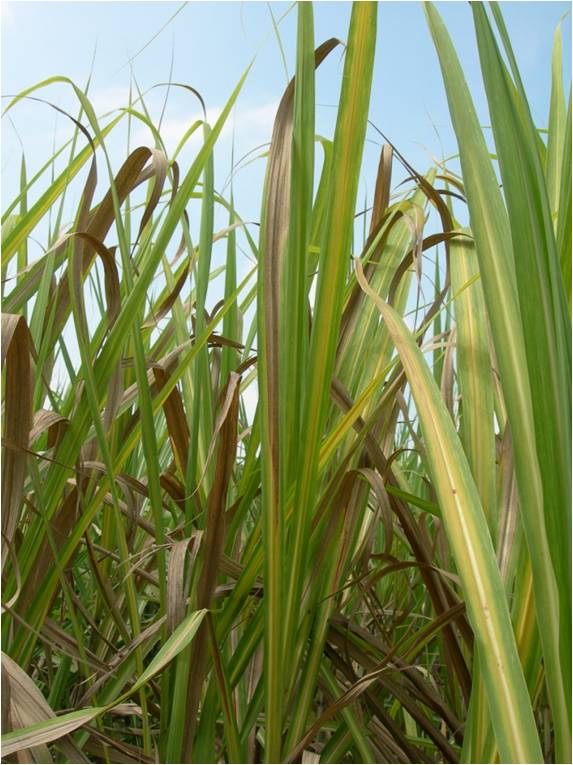
GSD
Causal organism:
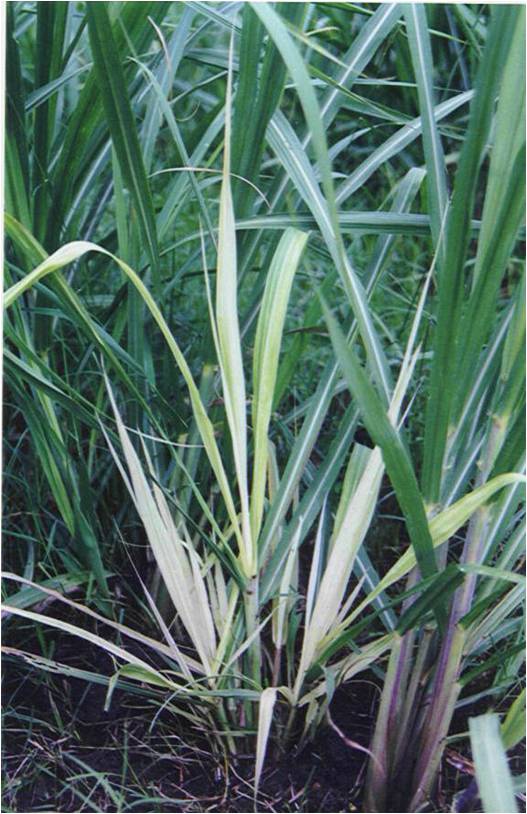
Symptoms
Wilt
Causal organism: Fusarium sacchari
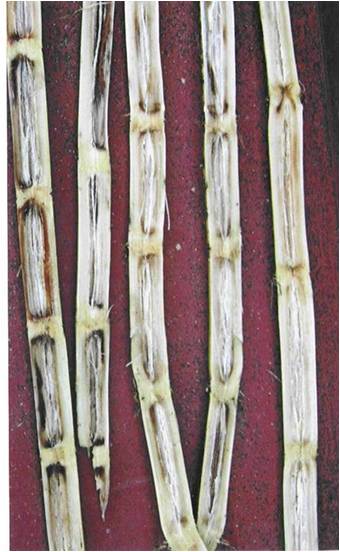
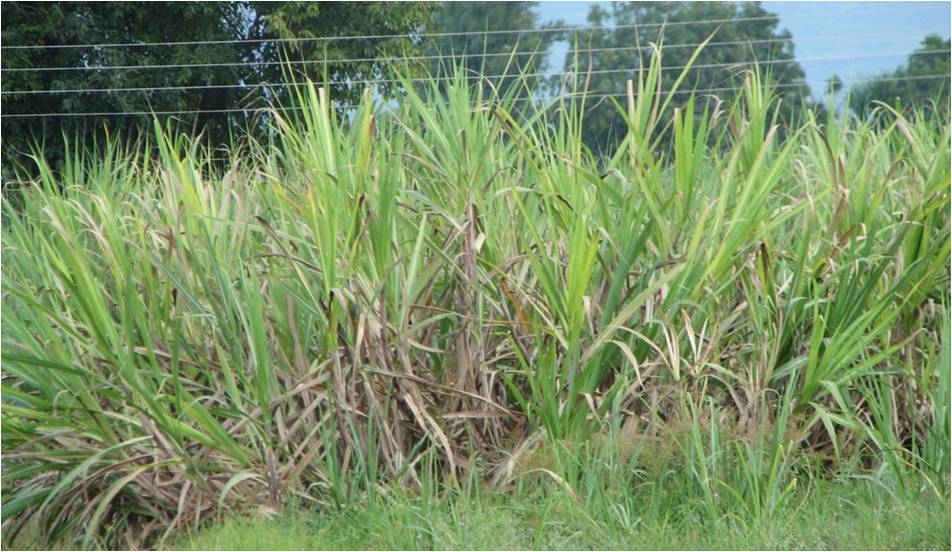
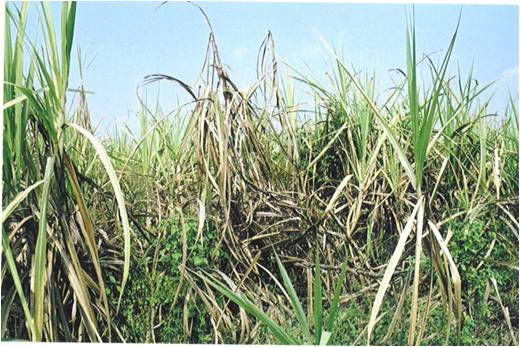
Symptoms
Sugarcane is ready for harvest in about 11-12 months after planting depending on the variety and the season. The mature cane is yellowish with prominent eye buds, giving a metallic sound if tapped with fingers. Similarly, it breaks at nodes if bent. But, the real indicator for determining the maturity is the brix reading taken with hand refractometer. If the reading shows 19 and above, the cane is mature and ready for harvest. The stand of subsequent ratoon crop depends on the correct manner of harvesting. The cane should be cut as close to the ground level as possible with the help of a sharp knife. Care should be taken to give a horizontal smooth cut without damaging the eye bud below the soil. If the cane is harvested above the ground, the yield is reduced, sugar is lost in the lower portion (as the lower portion contains more sugars) and there is lodging as well as poor tillering in the ratoon, since the buds sprout from above the ground and have no support. On the other hand, if the cane is cut below the ground, the lower eye bud is damaged and this badly affects germination. Use of improved 'Vikas' knife developed by Vasantdada Sugar Institute cuts the cane at right place with ease and gives a smooth cut thus avoiding the trouble of stubble shaving operation for ratoon crop
In Goa, 65-70 per cent of area under sugarcane is retained as ratoon crop. Ratooning offers many advantages in the economy of cultivation since it saves the cost on procurement and preparation of setts, land preparation, planting, etc. The productivity and quality of ratoon crop in Goa are very poor since most of the ratoons are neglected or subjected to mismanagement. The productivity of ratoon can be upgraded to the level of plant crop or even better, provided sound ratoon management practices are followed by cane growers.
Input availability |
Address/Contact details |
| Seeds | ICAR-CCARI, Old Goa, Directorate of Agriculture- Tonca Panaji-Goa, Goa Bhagayatdar Society,Ponda-Goa. |
Fertilizers |
For detailed list kindly click here |
Pesticides |
For detailed list kindly click here |
| Machineries | Goa Tractors Mapusa-Goa, Varsha Associates Corlim-Goa |
|
